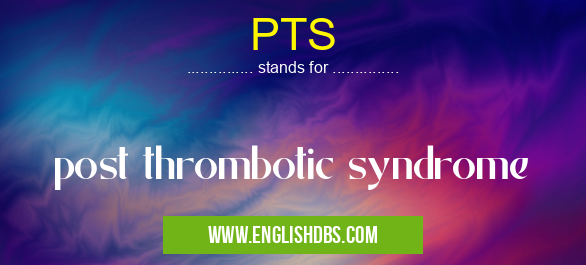What does PTS mean in BRITISH MEDICINE
Post Thrombotic Syndrome (PTS) is a complication of deep vein thrombosis, or DVT, that can cause pain and discomfort in the affected limb. It can be characterized by chronic swelling, skin discoloration, and even ulceration. In some cases, it can even cause life-long disabilities. Fortunately, there are medical methods available to treat PTS and minimize its effects. Understanding what PTS is and how it develops will help us better understand the treatment options available.

PTS meaning in British Medicine in Medical
PTS mostly used in an acronym British Medicine in Category Medical that means post thrombotic syndrome
Shorthand: PTS,
Full Form: post thrombotic syndrome
For more information of "post thrombotic syndrome", see the section below.
What Is Post Thrombotic Syndrome?
Post Thrombotic Syndrome (PTS) is a medical condition resulting from deep vein thrombosis (DVT), which is a blood clot in one of the larger veins located in the lower half of the body. When this happens, the veins in that particular area may become blocked or narrowed due to scarring or tissue damage caused by the clotting process. This blockage or narrowing can lead to decreased blood flow to that area and can eventually result in inflammation and swelling known as PTS. Other symptoms include leg pain, cramps, skin discoloration at the affected site, and even ulcers in severe cases. In more severe instances, PTS may also cause long-term disability due to nerve damage or poor circulation in that area.
Treatment Options For Post Thrombotic Syndrome
Medical treatment for PTS varies depending on its severity but usually includes compression therapy using compression stockings or bandages to help reduce swelling and improve circulation at the affected site. Physical therapy such as stretching exercises is recommended in order to keep muscles flexible and reduce tension on swollen areas; additionally, elevating the legs can help with circulation problems associated with PTS. There are also medications prescribed for more serious cases such as anticoagulants like warfarin which helps prevent further clot formation; antibiotics used for treating existing infections; as well as diuretics which help reduce fluid retention often associated with PTS. In more severe cases where swelling persists despite other treatments being employed, surgical options may be recommended to provide relief by removing any blockages present causing restricted blood flow.
Essential Questions and Answers on post thrombotic syndrome in "MEDICAL»BRITMEDICAL"
What is post-thrombotic syndrome?
Post-thrombotic syndrome (PTS) is a chronic condition caused by deep vein thrombosis (DVT). It occurs when a blood clot, or thrombus, forms in the veins of your lower leg and leads to long-term health problems. Symptoms can include swelling, pain, discoloration, and ulcers of the skin.
What are common symptoms of post-thrombotic syndrome?
Common symptoms associated with PTS include persistent swelling in the affected leg, pain, aching, and cramping sensation as well as fatigue and tenderness in the calf area. Other indicators can include skin discoloration or thickening, itching and the development of ulcers on the skin.
Who is at risk for developing post-thrombotic syndrome?
Those who have already experienced an episode of DVT or are at risk for developing it due to lifestyle factors such as smoking or sitting for long periods of time are more prone to having PTS. People who have a family history of venous disease may also be more likely to develop it.
How is post-thrombotic syndrome diagnosed?
Diagnosis typically involves physical examination by a doctor combined with imaging tests such as Doppler ultrasounds or computed tomography scans to evaluate blood flow in the veins. In some cases, additional tests may be necessary to confirm diagnosis.
How is post-thrombotic syndrome treated?
Treatment options for PTS vary depending on severity but may include lifestyle modifications such as wearing compression stockings during activities; medications including anticoagulants or antiplatelet agents; and interventional procedures such as balloon angioplasty or stenting which can help improve circulation in blocked veins.
Are there any complications associated with post-thrombotic syndrome?
Untreated patients with severe post-thrombotic syndrome may be at risk for developing serious complications such as recurrent DVT formation or pulmonary embolism due to reduced blood flow in affected veins. In rare cases other complications may also arise due to venous insufficiency.
Are there any preventative measures against post - thrombotic syndrome?
There are several preventive measures that can reduce your risk of developing PTS if you’ve had a previous instance of DVT. These include avoiding prolonged sitting; exercising regularly; quitting smoking; maintaining healthy body weight; keeping legs elevated when possible; not crossing your legs while seated; and wearing compression stockings during activities.
Final Words:
Post Thrombotic Syndrome (PTS) is a common complication of deep vein thrombosis (DVT). It leads to symptoms such as pain and swelling at affected sites along with discoloration of skin at those sites as well as potential long-term disabilities if left untreated. Fortunately there are different treatments available depending on severity including compression stockings/bandages for compression therapy; physical therapy; medications like warfarin and diuretics; and surgery when necessary. Knowing what PTS is and what treatments are available will help us better manage this condition should it occur.
PTS also stands for: |
|
| All stands for PTS |
